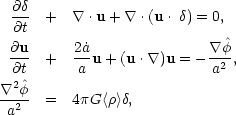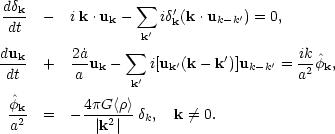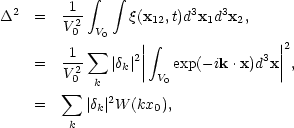


5.1. Newtonian theory for the growth of small irregularities
If the characteristic wavelength of a perturbation is much smaller than the horizon and the gravitational effects of pressure may be ignored, one can conveniently describe the evolution of irregularities within the framework of Newtonian theory (Bonnor, 1957). The justification for this comes from Birkhoff's theorem in general relativity (e.g. Weinberg, 1972, Section 11.7). Below we shall employ the fluid approximation, and the effects of matter pressure will be ignored. The equation of continuity and the Euler equation may be written,
 |
(5.1a) (5.1b) |
together with Poisson's equation,
 |
(5.1c) |
It proves convenient to transform from the variables (r, v) into comoving coordinates (x, u) defined by
 |
(5.2a) (5.2b) |
where a(t) is the cosmological scale factor and a dot denotes the derivative with respect to t. In comoving coordinates, Eqs. (5.1) read,
 |
(5.3a) (5.3b) (5.3c) |
where  is defined by
is defined by
 (x,
t) =
<
(x,
t) =
< >(1 +
>(1 +
 ) and
<
) and
< > is the
mean matter
density. For mathematical convenience we now assume that the matter
distribution is periodic in a cube of volume Vx,
chosen to be large enough that any clustering on scales corresponding to
Vx may be
neglected, and we define the Fourier transforms of quantities such as
> is the
mean matter
density. For mathematical convenience we now assume that the matter
distribution is periodic in a cube of volume Vx,
chosen to be large enough that any clustering on scales corresponding to
Vx may be
neglected, and we define the Fourier transforms of quantities such as
 ,
u
,
u ,
,
 according to,
according to,
 |
(5.4a) |
and the inverse transform,
 |
(5.4b) |
In terms of the Fourier transformed variables, Eqs. (5.3) take the simple form,
 |
(5.5a) (5.5b) (5.5c) |
The terms under the summation signs represent the non-linear effects
which couple modes. The main virtue of the Fourier transformed
variables is that the linear theory may be applied to large
wavelengths even when the matter is highly non-linear on small scales
- if the mode coupling terms are small. This point will be discussed
further below, but for the moment we will simply ignore the non-linear
terms. In this case, the evolution of
 k is
given by the usual linear theory equation (e.g.
Weinberg, 1972,
Section 15.9)
k is
given by the usual linear theory equation (e.g.
Weinberg, 1972,
Section 15.9)
 |
(5.6) |
In an Einstein-de Sitter universe,
a(t)  t2/3, hence Eq. (5.6) has the power law solutions
(Peebles and Dicke, 1968),
t2/3, hence Eq. (5.6) has the power law solutions
(Peebles and Dicke, 1968),
 |
(5.7a) |
where Ak and Bk
are fixed by specifying
 k and
uk at some initial epoch ti ,
k and
uk at some initial epoch ti ,
 |
(5.7b) (5.7c) |
The velocity field is fixed by Eq. (5.5b),
 |
(5.7d) |
Now, in a low density universe, with present density
 0
<< 1, the scale factor behaves as
a
0
<< 1, the scale factor behaves as
a  t2/3 for 1 + z >> 1 /
t2/3 for 1 + z >> 1 /
 0
and a
0
and a  t
for 1 + z << 1 /
t
for 1 + z << 1 /
 0,
hence at late times, the solutions to Eq. (5.6) take the form,
0,
hence at late times, the solutions to Eq. (5.6) take the form,
 |
(5.8) |
Hence in a low density universe, perturbations effectively stop
growing at redshifts zf
 1 /
1 /
 0 - 1.
0 - 1.
Henceforth we shall concentrate on the dominant modes in Eqs. (5.7) and (5.8) and we shall make the simplifying assumption of a power law spectrum of fluctuations,
 |
(5.9) |
where each of the Ak has a randomly assigned phase.
As measures of the dumpiness of the matter distribution we shall
consider first the auto-correlation function
 (x)
defined as,
(x)
defined as,
 |
(5.10) |
where, the angular brackets denote an average over the volume Vx. Hence from Eq. (5.4b)
 |
(5.11) |
i.e. the auto-correlation function is just the Fourier transform of
the power-spectrum
| k|2.
As a second measure of
clustering, consider the mean square density contrast in randomly placed
spheres of comoving volume V0:
k|2.
As a second measure of
clustering, consider the mean square density contrast in randomly placed
spheres of comoving volume V0:
 |
(5.12) |
then by Eq. (5.10)
 |
(5.13) |
where x0 is the radius of the sphere of volume V0 and,
 |
Since the function W has the asymptotic behaviour,
W(y)  1
for y << 1, W(y) ~ 1/y4 for
y >> 1, Eqs. (5.13) and (5.19)
yield for n < 1,
1
for y << 1, W(y) ~ 1/y4 for
y >> 1, Eqs. (5.13) and (5.19)
yield for n < 1,
 |
(5.14) |
where k0 = 2 /
x0. If n > 1 the dominant contribution to
/
x0. If n > 1 the dominant contribution to
 2 comes from
the side lobes of the window function W, hence
2 comes from
the side lobes of the window function W, hence
 2(x0) does not yield a
good estimate of the mean square density contrast on scales
x0.
Physically, this is because for a sufficiently subrandom distribution
the measure
2(x0) does not yield a
good estimate of the mean square density contrast on scales
x0.
Physically, this is because for a sufficiently subrandom distribution
the measure
 2 becomes
sensitive to whether clumps fall inside or
outside the sharp edge of the sphere. The problem may be alleviated by
weighting the integral (5.12) by factors which eliminate the
side-lobes in the window function W, for example one could use
Gaussians
exp(- x2 / 2x02). The
mean squared density contrast may then
be adequately approximated by Eq. (5.14)
(Peebles and Groth
(1976)).
2 becomes
sensitive to whether clumps fall inside or
outside the sharp edge of the sphere. The problem may be alleviated by
weighting the integral (5.12) by factors which eliminate the
side-lobes in the window function W, for example one could use
Gaussians
exp(- x2 / 2x02). The
mean squared density contrast may then
be adequately approximated by Eq. (5.14)
(Peebles and Groth
(1976)).
The linear theory is expected to fail on scales
xm where
<(
 /
/
 )2>xm ~ 1. From
Eq. (5.14),
)2>xm ~ 1. From
Eq. (5.14),
 |
(5.15) |
Hence, the characteristic length scale on which perturbations are currently entering the non-linear regime of growth evolves as
 |
(5.16) |
This is an important result since it suggests a possible observational
test for the index n. If
n  - 3, a wide
range of scales will reach the
non-linear regime of growth almost simultaneously, one would then
expect bound structures to have almost the same internal densities
independent of their size. In contrast, if n > - 3, structure
on small
scales will condense at an early stage when the mean density of the,
Universe was much higher than it is now, one then expects that the
internal densities of bound lumps would be strongly dependent on their
size. These arguments will be made more quantitative in
Section 5.3 below
- 3, a wide
range of scales will reach the
non-linear regime of growth almost simultaneously, one would then
expect bound structures to have almost the same internal densities
independent of their size. In contrast, if n > - 3, structure
on small
scales will condense at an early stage when the mean density of the,
Universe was much higher than it is now, one then expects that the
internal densities of bound lumps would be strongly dependent on their
size. These arguments will be made more quantitative in
Section 5.3 below
One point of concern in the derivation of Eq. (5.16) is the
justification of the validity of linear theory for
 k. Indeed,
Press and Schechter (1974)
have argued that when the matter distribution is
highly non-linear for
k
k. Indeed,
Press and Schechter (1974)
have argued that when the matter distribution is
highly non-linear for
k  km, the mode-coupling terms in Eqs. (5.5)
might become important for
k << km invalidating the linear theory
results of Eqs. (5.7) and (5.8). This problem is discussed in detail
by Peebles
(1974b, and
1980a,
Section 28). Although it is difficult to
provide a rigorous proof, Peebles' consistency argument suggests that
the linear theory is valid if n < 4. If n
km, the mode-coupling terms in Eqs. (5.5)
might become important for
k << km invalidating the linear theory
results of Eqs. (5.7) and (5.8). This problem is discussed in detail
by Peebles
(1974b, and
1980a,
Section 28). Although it is difficult to
provide a rigorous proof, Peebles' consistency argument suggests that
the linear theory is valid if n < 4. If n
 4, the small-scale motions
of particles generate a spectrum
|
4, the small-scale motions
of particles generate a spectrum
| |2
|2
 k4
as discussed at the end of
Section 3.2. Perhaps the best test of the
linear theory results come from numerical N-body experiments
(Peebles and Groth, 1976;
Efstathiou, 1979);
these will be discussed in Section 5.3 below.
k4
as discussed at the end of
Section 3.2. Perhaps the best test of the
linear theory results come from numerical N-body experiments
(Peebles and Groth, 1976;
Efstathiou, 1979);
these will be discussed in Section 5.3 below.